Whether you’re in manufacturing or industrial design, aerospace or healthcare, adding 3D printing to your business can be a step in the right direction when it comes to environmental sensitivity and sustainable practices, such as reducing your carbon footprint, creating less waste, and using less energy and fewer raw materials.
One advantage 3D printing (also called additive manufacturing) has when it comes to sustainability is that all sorts of parts, whether they’re models, prototypes, tools, molds, or final products, are made by adding material instead of subtracting it. Traditional subtractive manufacturing requires more raw materials upfront and produces more waste. For example, an engine part prototype requires far less material to 3D print than to machine from a block of metal.
The U.S. Department of Energy estimates that (compared to traditional manufacturing) AM might slash waste and materials costs by nearly 90% and cut manufacturing energy use in half. This is encouraging news for any company considering the economic and environmental advantages of 3D printing.
But how environmentally friendly is 3D printing in practice today? Let’s take a look at the sustainability advantages and drawbacks of additive manufacturing.
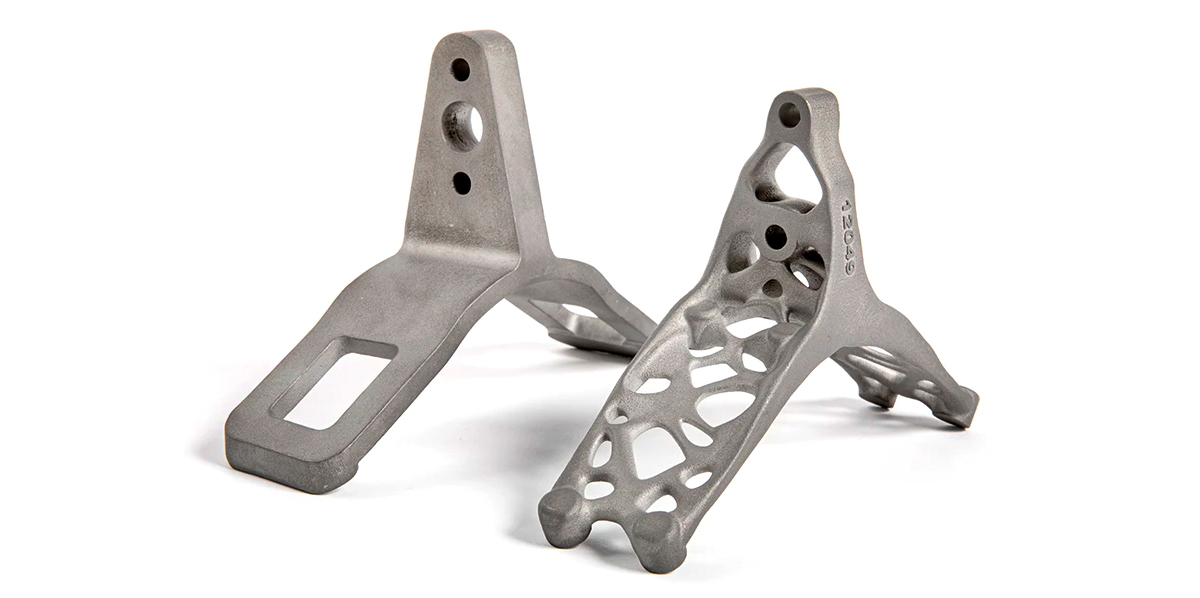
What the Research Says
There’s plenty of anecdotal information about how companies have saved time, money, and materials by using 3D printing instead of forging, casting, or machining metal or molding plastic. But there’s thin scholarly research.
Last week, the Additive Manufacturing Green Trade Association (AMGTA) released research directly comparing a 3D printed aerospace part to a conventionally manufactured equivalent. Although the comparative end result was inconclusive with regard to which manufacturing method used more energy, the results confirmed the dramatic impact that 24 of these 3D printed parts (which were designed to be 50% lighter weight) had on the aircraft’s carbon emissions saving 13,376 kg of emissions for every 1 kg of weight reduction. Another recent sustainability study from the University of Lisbon compared the environmental footprint of metal 3D printing to conventional manufacturing and found a material saving of 40% to 70% and an environmental impact reduction of 12% to 47% for the 3D printed part.
These studies used the Life Cycle Assessment methodology to assess environmental impact, which takes into account all the stages of of a product, from initial design all the way through to recyclability at the end of life. This is an important distinction since additive manufacturing “generally has much higher carbon footprints per kilo of material processed than CM (conventional manufacturing) when considering the direct manufacturing process itself,” another AMGT study on sustainability in metal additive manufacturing found.
In fact, additive manufacturing’s sustainability doesn’t begin and end with the manufacturing stage. 3D printing as a sustainable practice starts with designing for the method, which involves making parts that are smaller, lighter, more durable, and more efficient, then selecting sustainable or recycled materials, then manufacturing locally. Let’s dig a little deeper.

Circular Economy Potential of 3D Printing
For all companies to become more sustainable and environmentally friendly – which everyone from governments to trade groups to consumers agree should happen – more effort is needed to solve the problems of waste, pollution, and overconsumption of energy and raw materials. Even small companies have a role to play in recycling, making purchasing decisions with sustainability in mind, shortening their supply chains, and switching to greener office and production practices, such as reducing energy use.

As one example, the European Union has a goal to make all plastic packaging in Europe is recyclable by 2030. What does this have to do with 3D printing? Well, consumer-grade thermoplastics used in packaging can be a low-cost and sustainable feedstock for 3D printing, providing a high-value output for waste plastics, according to a recent study. Using local plastic waste as raw material is one of the potential major benefits of additive manufacturing, and we’re already seeing it.
German automaker Audi, for example, recently launched a program to shred the industrial packaging it receives and feed it into a filament maker to use in its 3D printers and produce factory tools.
In the aspirational circular economy where everything made can be recycled, every company that 3D prints could use recycled material as the raw material and then further recycle or repurpose that material after the printed part is obsolete. Although we haven’t reached this goal yet, there are many promising examples and a growing number of recycled plastics on the market for use in 3D printing ranging.
3D printing today enables companies to save on raw materials, produce less waste, and other major environmentally friendly advantages. We found seven ways 3D printing today can help companies go green.
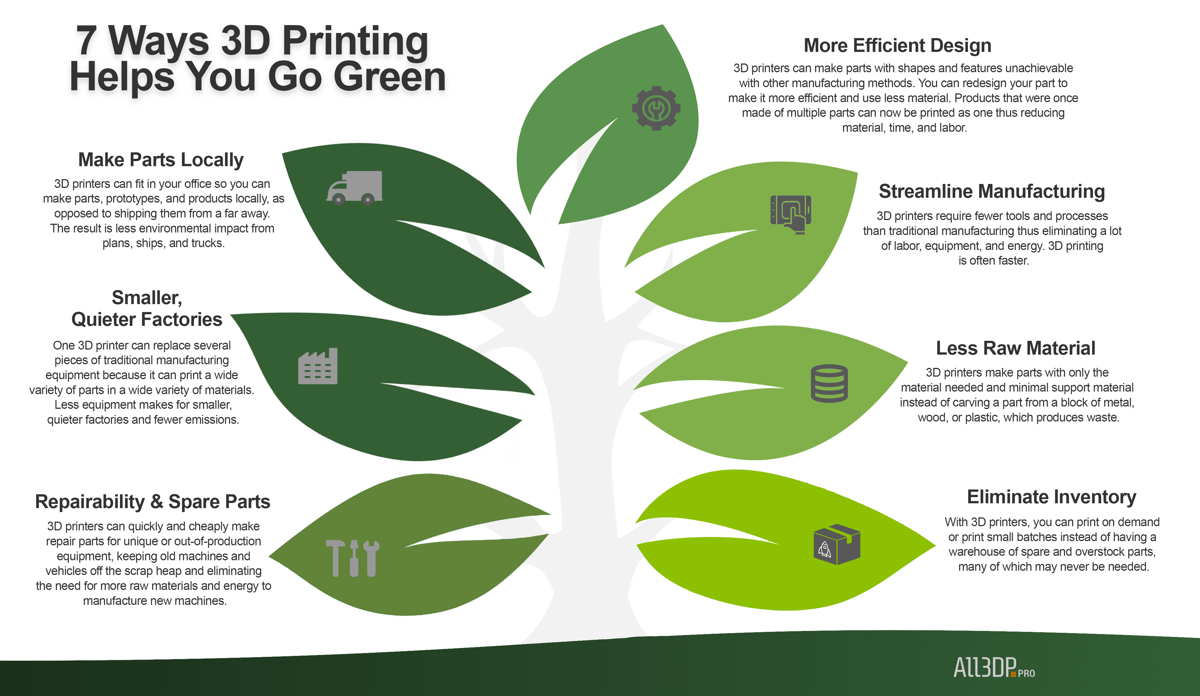
7 Ways 3D Printing Helps You Go Green
Additive manufacturing enables businesses to reduce, reuse, repurpose, and recycle. Let’s take a closer look.
1. Design More Efficiently
3D printers can make parts with shapes and features unachievable with other manufacturing methods. You can redesign your part or product to make it smaller, more efficient, and use less material. Products that were once made of multiple parts can now be printed as one, reducing material, time, and labor.
Manufacturers using 3D printing can print full moving assemblies and intricate parts, such as fuel injectors, as one piece instead of several components that have to be printed separately and then assembled, so there’s less waste product and energy used. From cars and rockets to hydraulics and heat exchangers, engineers are using 3D printing to create higher-functioning, more efficient, lighter, and smaller parts that replace multi-piece components.
The knock-on effect of this more efficient part design optimization (called topology optimization) and part consolidation are products, such as cars and aircraft, that use less raw material and are lighter, and therefore are more fuel efficient and emit fewer greenhouse gases.
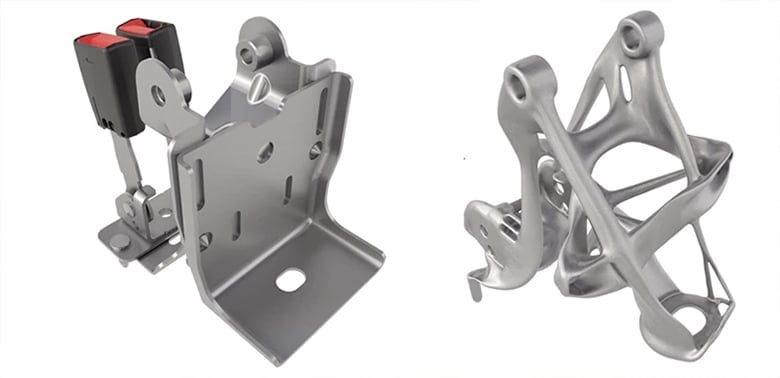
2. Use Less Raw Material
Whether it’s metals or plastics, 3D printing puts the material precisely where it’s needed to create a part, instead of carving out a part from a block of material or pouring molten material in a mold and creating scrap material. Metal scrap from conventional manufacturing methods is typically recycled and used in downstream applications, but only after energy is used to collect it, ship it, and process it.
Although additive manufacturing is not a completely waste-free technology, left-over metals and resins from one print can be used directly for the next print and unusable waste, except for resin, is recyclable.
Because 3D printing requires less raw material upfront, companies that manufacture parts with very expensive metals, such as titanium and some alloys used in space, can experience large cost savings.
3. Repairability & Spare Parts
3D printers can quickly and cheaply make repair parts for unique or out-of-production equipment, keeping old machines and vehicles off the scrap heap and eliminating the need for more raw materials and energy to manufacture new machines and industrial components. On the consumer level, 3D printers are increasingly used for household spare part production with major home appliance manufacturers, including Miele, providing digital files.
With the push of a button, engineers can print a part that hasn’t been manufactured in decades. For example, many militaries around the world are adopting 3D printing to extend the lifespan of older vehicles and print repair parts in the field. Airbus subsidiary Satair, for example, 3D-printed a certified, flight-worthy aircraft spare part that was no longer procurable from the original supplier and would have been too costly to manufacture with traditional means.
Some metal additive manufacturing technologies (such as cold spray and laser metal deposition) can repair worn-out metal parts in instances where welding, cladding, or other traditional repair methods aren’t suitable. Laser metal deposition has saved millions of dollars for heavy industry and aerospace by enabling companies to repair parts instead of making new ones.
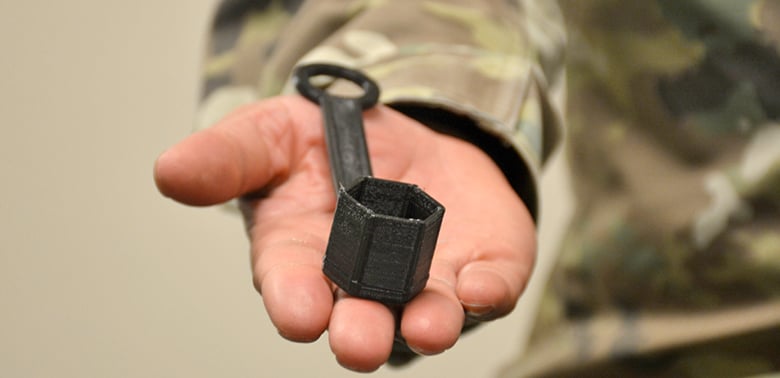
4. Make Parts Locally
Office-size 3D printers enable small businesses to make parts, prototypes, and products locally, as opposed to shipping them from far away. The result is less environmental impact from plans, ships, and trucks. But this practice isn’t limited to small businesses. Large auto manufacturers and energy giants alike are adopting more additive manufacturing, either in-house or at a local on-demand 3D printing service, to deliver parts faster and eliminate supply chain risks.
This on-shoring effort hasn’t faded away with the global pandemic. Lessons learned from COVID, sanctions, and the conflict in Ukraine, have inspired a movement among manufacturers and businesses to reevaluate their supply chains.
One interesting example is the home construction company Mighty Buildings, which 3D prints house walls out of a partially recycled polymer. The company says its new business model is to establish 3D printing home factories alongside the housing developments it creates.
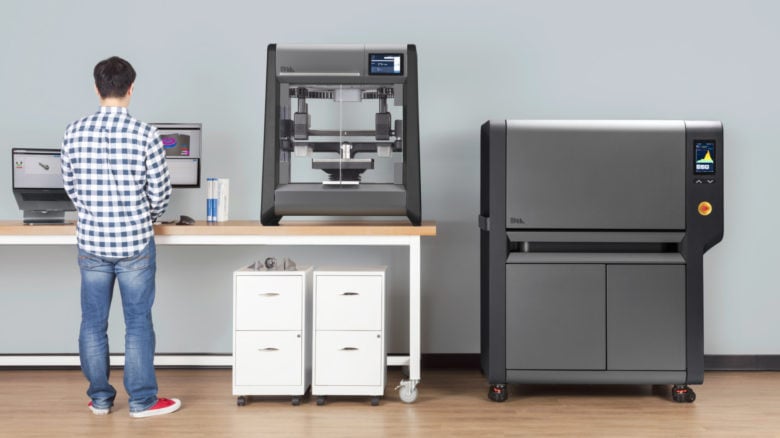
5. Eliminate Inventory
With 3D printers, you can print on demand or print small batches instead of having a warehouse of spare and overstock parts, many of which may never be needed.
One example is the dozens of eyewear brands that have partnered with 3D printing service company Materialise to bring 3D printed eyewear collections to the market. Each eyeglass frame can be customized to the wearer and manufactured on demand, eliminating stock.
“Stock wastage has historically been a huge issue for the eyewear industry,” says Alireza Parandian, Materialise’s wearables expert. “The dream scenario is to be able to offer new eyewear designs, in multiple materials, that can be produced at a speed and quantity that matches demand while simultaneously reducing wastage and revenue-threatening stock risk.”
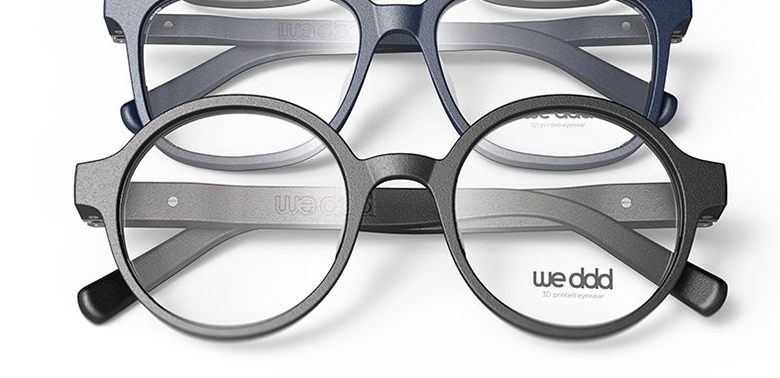
6. Streamline Manufacturing
3D printers require fewer tools, parts, and processes than traditional manufacturing eliminating much of the labor, equipment, and energy. 3D printing is often faster.
Unlike other types of manufacturing, additive manufacturing is a computer-to-part method, meaning there’s no tooling or molds and very little labor between a digital design and its production (although some methods require post-processing).
Compare, for example, 3D printing to plastic molding to make medical models. A hospital could use its 3D printer to print virtually any model in different materials and colors. The same models made by plastic molding would first require separate molds to be fashioned for each item, then a machine would melt a single plastic and pour it in the mold – a process that would need to be done at a factory. With 3D printing, the hospital can create any medical model, even patient-specific models, using just one machine that fits in an office, which is a much faster and cheaper method.
7. Smaller, Quieter Factories
One 3D printer can replace several pieces of traditional manufacturing equipment because it can print a wide variety of parts in a wide variety of materials. Plus, it’s a highly automated process requiring less labor and is capable of operating 24/7 without supervision. Less equipment makes for smaller factories and fewer emissions. 3D printing facilities can be in urban centers or closer to the point of need rather than in an industrial park or away from residences. Plus, from the perspective of noise pollution, 3D printers are measurably quieter than traditional manufacturing equipment.
3D Printing’s Sustainability Challenges
Any one of the points above could be reason enough for companies to turn to additive manufacturing to become more sustainable. However, despite the sustainability features and potential, 3D printing is not completely green.
The biggest environmental challenge in additive manufacturing today is what to do with waste, such as failed and obsolete prints, excess or used liquid resins and plastic powders, support material, and metal printing byproducts.
Although there’s little data on the total amount of waste that AM adds to the environment, the easier and cheaper it becomes for professionals and consumers to 3D print, the more they will print, says Jeremy Faludi, a leading researcher into the sustainability of additive manufacturing. As low-cost 3D printers enable designers to produce quick, multiple iterations of prototypes, it creates a new waste issue. A survey by the recycled filament maker Filamentive found that as much as 8 million kilos of 3D printed plastic waste was generated in 2020, most of which ended up in landfills.

Lack of Industrywide Recycling Initiatives
Although the most popular plastic filament for 3D printing, PLA (polylactic acid), is a biodegradable thermoplastic made from renewable resources like cornstarch or sugar cane, it is only biodegradable after industrial handling and can’t be processed at typical consumer recycling or composting centers. Although AM has great potential to create a closed loop for material use – recycling printed parts back into raw material – in practice, it is far from the norm.
Today there are just a handful but a growing number of companies that produce plastic filaments from recycled plastic waste. Machines that enable companies to turn their own plastic prints back into filament are available from only a few machine suppliers, such as Filabot’s Reclaimer.
Today, there are more filaments made with stainable materials called bio-composites, such as oyster shell powder, hemp, and seaweed. However, along with the desire to be more sustainable are products that project an environmental image regardless of actually being sustainable.
Many plastics used in additive manufacturing are simply not recyclable, and others, because of environmental regulations, require special disposal methods. Worse yet, petroleum-based plastics like ABS (acrylonitrile butadiene styrene) are made by environmentally hazardous oil extraction and refinement practices, making them an unsustainable material choice.
It’s even more difficult to recycle or reuse plastics from selective laser sintering. “With laser sintering, the second most commonly used 3D printing technology, up to 50% of the powder becomes waste,” according to material manufacturer Materialise. “The potential to recycle used powder is limited and 3D printing with only used powder creates surface problems that make the 3D printed object unsuitable for most applications.”
This hurdle led Materialise to develop a polymer powder that can be 100% reused. However, this Bluesint PA12 material has seen slow commercial adoption. Instead, makers of selective laser sintering 3D printers have developed materials and process combinations to boost the percentage of powder that can be reused from one printer to the next.
Ford Motor Co. launched a program in 2021 that reuses the spent 3D printing polymer powders and parts as raw material for injection molding. The recycled materials are being used to manufacture injection-molded fuel-line clips installed first on Super Duty F-250 trucks.
“Many companies are finding great uses for 3D printing technologies, but … we’re the first to find a high-value application for waste powder that likely would have gone to landfill, transforming it into functional and durable auto parts,” says Debbie Mielewski, Ford technical fellow, Sustainability.
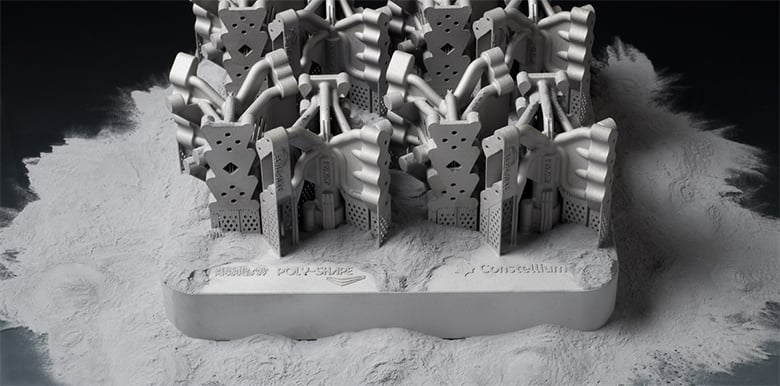
Metal Recycling and Energy Consumption
Metal powder left over from a print can be reclaimed and reused for more prints, but, like polymer powder, there’s a limit to the number of times it can be reused and maintain its integrity. In many high-tech industries, such as aerospace, specific and verifiable metal qualities are required, which discourages reusing material.
Eventually, businesses must dispose of their excess metal powder like they would any metal scrap, and it typically doesn’t end up in landfills. Metal powder condensate, however, which is also produced in the metal printing process, has to be disposed of according to hazardous waste guidelines.
Creating metal powder for additive manufacturing from metal raw material is done using atomization, which is an energy-hungry process that also creates some metal byproduct.
Faludi and his co-author, Corrie Van Sice, concluded, in recent AMGTA research, that metal 3D printing “is an environmental benefit when resource-intensive materials such as titanium are greatly reduced, or when lightweight designs enabled by AM result in significant energy savings in the use phase. However, because it is unclear where these benefits will be strong enough to overcome the increased processing energy, much more research is required to enable modeling and prediction to support decision-making.”
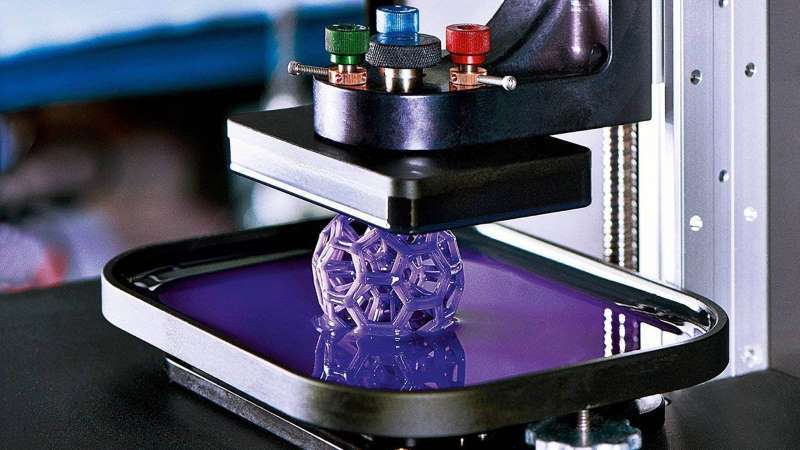
What to Do With Used Resin?
Vats of liquid plastic used in resin 3D printers, like beds of metal powders, can be used over again until the resin is either used up or contaminated, which can occur after a certain number of prints. Resin is considered hazardous waste in liquid form and unrecyclable plastic waste in solid form. Resin printed parts often require support structures that are removed from the final part and also end up in landfills because the material can not be recycled.
Although research is underway to develop recyclable resins, more environmentally friendly resin materials, such as from used cooking oil from McDonald’s, commercially available products, aside from one, Recyclamine, are scarce.
The Energy Consumption Question
There’s no doubt that 3D printers, especially those that reach very high temperatures and use lasers, require substantial amounts of electricity. Yet researchers are split on whether or not additive manufacturing, in general, uses less or more energy than traditional methods of manufacturing because each use case – depending on the technology and material – is different. Referring to the same recent AMGTA report mentioned above that compared a 3D printed aircraft bracket to a conventionally produced bracket, the results indicated that, strictly from a manufacturing standpoint, the traditional bracket required less energy to produce, while the AM version produced less carbon dioxide. However, the study found that the energy mix of the underlying electrical grid had an outsized effect on the sustainability of the manufacturing process.
If you look instead at the energy savings that the use of additive manufacturing can promote in other industries, it’s a clear win. For example, considering that 28% of total U.S. energy consumption is for transporting people and goods, the use of 3D printing to make vehicles lighter and more fuel efficient coupled with distributed manufacturing, which reduces the need to transport certain goods at all, the effects on energy consumption can be substantial.
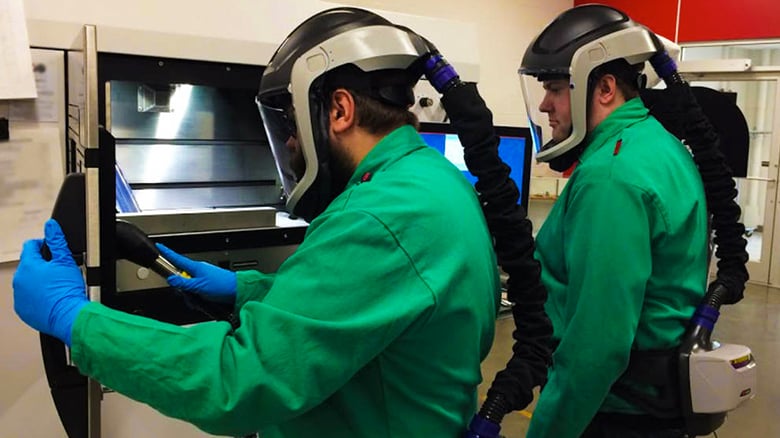
Health Hazards of Additive Manufacturing
From research in other industries, it’s known that breathing in tiny particles of metal powders or gasses from heated plastics can lead to serious health consequences, yet research is sparse on whether additive manufacturing poses any health risks to workers who are equipped with the recommended personal protective equipment and follow printer manufacturer guidelines for ventilation and material handling. Most professional and industrial 3D printers have closed environments and emission filters that limit workers’ exposure to harmful plastic or metal particles. Many industrial printers also automate the post-processing stage so workers aren’t exposed to a part until it is in its final state.
“In the industrial [AM] context, a higher level of safety is in place. However, there are more dangerous risks, and accidents may happen,” says Vincenzo Lunetto in his research, Sustainable Design and Manufacturing 2018. “Moreover, the effects of chronic exposure to metal powders are still unclear and the reactivity properties of the various AM materials need to be documented.”

Why Pursue Sustainability
The fact is that 3D printing today can be very green and has the potential to be even greener as recycling technology and raw material development advances. “Technologies exist today that can radically reduce 3D printing’s impacts – to roughly 70% less … per part than injection-molding – through low-energy printing of abundant, non-toxic, renewable, compostable ingredients, with tunable physical properties,” notes Faludi in his 2017 research.
However, sustainability is a choice. Companies that choose toxic, non-renewable materials; print with little regard for material conservation or worker safety; and discard unused prints instead of recycling them are not practicing additive manufacturing to its sustainable potential.
In the end, it’s not the manufacturing method but the choices of the end-user businesses – or even additive manufacturing as an industry – that may determine the sustainability of 3D printing.
So why choose to be sustainable?
“Sustainability can be – and should be – one of the selling points of adopting AM,” says Sherry Handel, former executive director of the AMGTA.
Current and potential government regulations in the EU and the US that penalize companies on their carbon footprints and reward, with grants and tax breaks, efforts to adopt sustainable practices are another incentive to adopt additive manufacturing. (However, without research proving that AM is green, companies may not qualify for government incentives.)
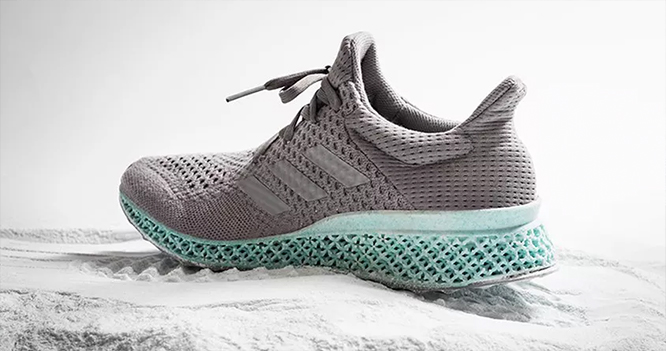
In addition, the consumer appeal of sustainability should not be underestimated. Environmental sensitivity is increasingly important in consumer decision making, especially with younger consumers choosing companies that are “greener” than their competition. When companies choose to adopt additive manufacturing, they can boast about the material they are conserving, among other benefits. Consumers, in return, can feel good about a purchase that promotes sustainability, such as the Adidas 3D printed sneaker made from ocean plastic or, on a local level, products from companies like the Canadian retail shop The Rogerie, which are all 3D printed from local waste plastics.
Talented workers and investors likewise may be attracted to companies with a strong environmental ethos over those without.
3D Printing Will Grow Greener Over Time
Additive manufacturing is still a young industry full of innovative start-ups looking for ways to differentiate this market from traditional manufacturing. Start-ups in additive manufacturing are keenly aware of their potential to offer sustainable manufacturing alternatives to companies seeking to go green. Because AM is highly dependent on technology, it may be more flexible and adaptable and hold greater promise for growing even greener in the years to come.
There’s huge potential for additive manufacturing to be a part of the solution to a more sustainable future, but materials, technology, and industry practices still need to advance to make that happen.
License: The text of "7 Ways 3D Printing Helps You Become Sustainable" by All3DP Pro is licensed under a Creative Commons Attribution 4.0 International License.



